Dōgu refers to equipment used during the tea ceremony. A wide range of dōgu is considered necessary even during a very simple tea ceremony. Following are essential equipment used during a tea ceremony :
1. Chabako ( 茶箱 ) (a box used to keep tea utensils)
Chabako utensil box is used when a tea ceremony is held outside of the teacher’s own tea room or place.
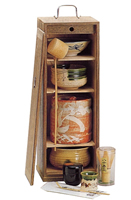
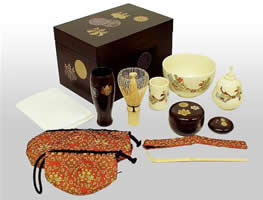
2. Chaki ( 茶器 ) (refers to tea utensils or a tea container)
It can mean various tea utensils that are used during the tea ceremony or a container for powdered green tea which is called Macha
3. Daisu ( 台子 ) (means tea utensil stand)
It is a portable, fairly large, shelf used to display tea utensils used during a tea ceremony.
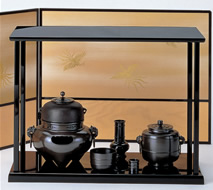
4. Dora ( 銅鑼 ) (copper gong)
Expert metal workers create these copper alloy gongs that make poignantly beautiful sounds during a tea ceremony
5. Hachi ( 鉢 ) (bowl used for sweets)
These are usually wooden or ceramic bowls. A pair of chopsticks is usually placed together with the Hachi,.
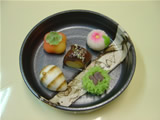
6. Hai ( 灰 ) (ash)
The fire pitin would have an ash bed referred to as Ash from where fire is lit.
7. Hana-ire ( 花入 ) (flower vase)
This is a flower vase that is made of bamboo when hung from the pillar of a Tokonoma (alcove)
8. Kaishi (Japanese style mini napkins)
These napkins are used during a Japanese tea ceremony particularly for either placing the sweets or sometimes cleaning the rim of the tea bowl or chawan after drinking Koicha.
9. Kan (かん) (Metal rings used to lift the Kama)
When removing the Kama from the fire pit , these metal rings are used to hold the Kama when transferring it to the Kamashiki. The Kama would be very hot to touch with just bare hands

10. Kouboku ( 香木 ) (scented wood)
Kouboku is used during the tea ceremony to create a calming and aromatic fragrance in the tearoom. Two pieces of wood are placed in the fire. They are also put in the Kougou so that when the Shoukyaku later asks for Haiken of the Kougou, additional pieces of Kouboku would be available.
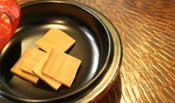 11. Kuromoji ( wooden chopsticks)
11. Kuromoji ( wooden chopsticks)
Kuromoji are used to place Wagashi sweets from a tray onto Kaishi paper during the
ceremony.
12. Neriko ( 練香 ) (blended incense)
This Japanese incense is used during winter as hot water is prepared. They appear like round balls which measure between 5 to 7 millimeters.
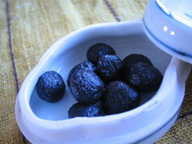 13. Ro ( 炉 ) (fire pit)
13. Ro ( 炉 ) (fire pit)
During winter when it is cold, the Kama is heated using fire created in the Ro on the floor which is placed on a Tatami mat.
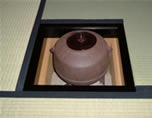 14. Tana ( 棚 ) (utensil stand)
14. Tana ( 棚 ) (utensil stand)
Tana refers to any kind of furniture made from wood or bamboo that is used during tea preparation. They vary in size, design and materials as well as features. The Tana is considered more casual compared to the larger utensil stand called daisu.
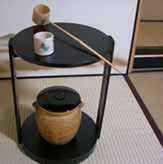 15 . Tenmoku ( 天目 ) ( narrow footed bowl)
15 . Tenmoku ( 天目 ) ( narrow footed bowl)
These tea bowls can be frequently seen during a Japanese tea ceremony. The Teishu and Kyaku both have to be careful when holding the bowl as it can easily topple over and spill its contents.
16. Tenmoku-dai ( 天目台 ) ( used for tenmoku bowls)
Since a Tenmoku tea bowl is narrow footed, a Tenmokudai can be used to prevent it from toppling over.
II. History of the Japanese Tea Ceremony
III. Types of the Japanese Tea Ceremony
IV. Preparing tea
V. Equipment used during a tea ceremony (temae)
VI. Tea Ceremony Equipment for Guests
VII. Rank of Tea Ceremony Utensils
VIII. Room Preparation for tea ceremony
